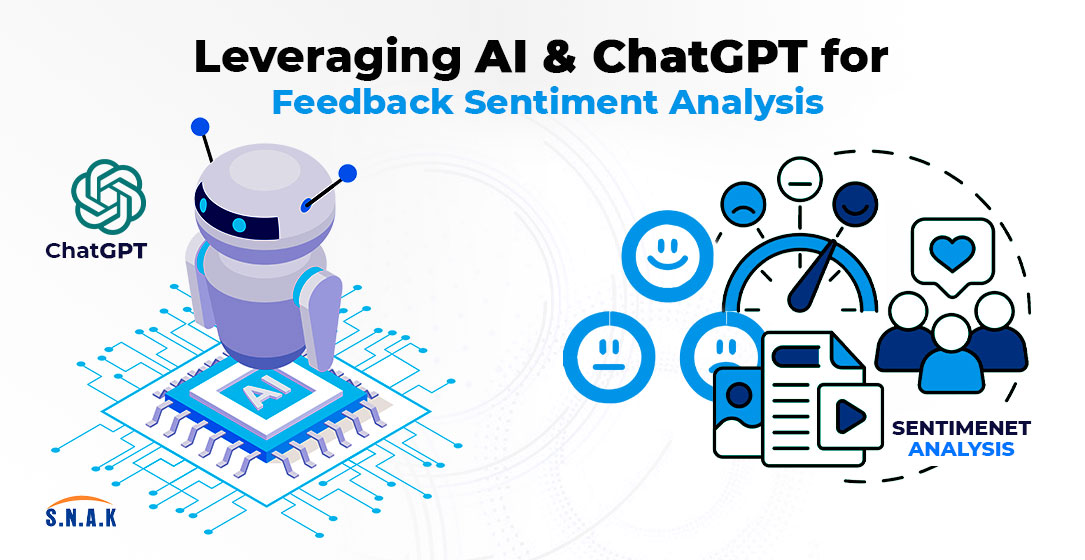April 3, 2024 | SNAK Consultancy
Share on :
Leveraging AI and ChatGPT for Feedback Sentiment Analysis

In today's digitally-driven world, businesses face an overwhelming influx of feedback from customers across various channels. Understanding the sentiment behind this feedback is crucial for organizations to make informed decisions and enhance customer satisfaction. Artificial Intelligence (AI) combined with ChatGPT, an advanced language model, offers a powerful solution for sentiment analysis, revolutionizing how businesses interpret and act upon feedback.
1. Introduction to Sentiment Analysis: Sentiment analysis involves the use of natural language processing (NLP) techniques to identify and categorize the sentiment expressed in textual data. It helps businesses gauge customer opinions, attitudes, and emotions toward their products, services, or brands.
2. The Role of AI in Sentiment Analysis: AI algorithms, particularly those powered by machine learning, play a pivotal role in sentiment analysis. These algorithms can be trained on large datasets of labeled feedback to recognize patterns and nuances in language, enabling them to accurately classify sentiment.
3. Introducing ChatGPT: ChatGPT, based on OpenAI's GPT architecture, is an AI language model trained on vast amounts of text from the internet. It excels in understanding and generating human-like text, making it an ideal candidate for sentiment analysis tasks.
4. How AI and ChatGPT Analyze Feedback: Leveraging AI and ChatGPT for feedback sentiment analysis involves several steps:
(a). Data Collection: Gather feedback data from various sources such as customer reviews, social media posts, surveys, and emails.
(b). Preprocessing: Clean and preprocess the text data to remove noise and irrelevant information.
(c). Sentiment Classification: Use AI algorithms, including ChatGPT, to classify the sentiment of each piece of feedback as positive, negative, or neutral.
(d). Analysis and Insights: Analyze the sentiment distribution to identify trends, common issues, and areas for improvement.
(e). Actionable Recommendations: Generate actionable recommendations based on the sentiment analysis results to address customer concerns and enhance satisfaction.
5. Benefits of AI-driven Sentiment Analysis:
(a). Scalability: AI-powered sentiment analysis can process large volumes of feedback data efficiently, allowing businesses to analyze feedback at scale.
(b). Accuracy: Advanced AI algorithms, such as ChatGPT, can accurately capture the nuanced sentiment expressed in feedback, leading to more precise insights.
(c). Real-time Insights: With AI-driven sentiment analysis, businesses can gain real-time insights into customer sentiment, enabling timely responses and interventions.
(d). Enhanced Customer Experience: By understanding and addressing customer sentiment effectively, businesses can improve the overall customer experience and loyalty.
6. Case Study: Provide a real-world example of a company that successfully implemented AI-driven sentiment analysis using ChatGPT, showcasing the benefits and outcomes achieved.
Questionnaire
Ques.1 What is sentiment analysis, and why is it important for businesses?
Ans. Sentiment analysis is the process of using natural language processing (NLP) techniques to determine the sentiment expressed in textual data, such as customer feedback or social media posts. It's essential for businesses because it provides valuable insights into customer opinions, attitudes, and emotions towards their products or services, helping them make data-driven decisions to enhance customer satisfaction and loyalty.
Ques.2 How does AI-powered sentiment analysis work?
Ans. AI-powered sentiment analysis involves training machine learning algorithms on large datasets of labeled feedback to recognize patterns and nuances in language. These algorithms, including advanced models like ChatGPT, can accurately classify sentiment as positive, negative, or neutral based on the content of the text.
Ques.3 What are the benefits of using ChatGPT for sentiment analysis?
Ans. ChatGPT, being an advanced language model trained on vast amounts of text data, excels in understanding and generating human-like text, making it highly effective for sentiment analysis tasks. Its ability to capture the nuances of language allows for more accurate sentiment classification and deeper insights into customer feedback.
Ques.4 How can businesses leverage sentiment analysis insights to improve customer experience?
Ans. By analyzing sentiment analysis results, businesses can identify trends, common issues, and areas for improvement in their products or services. They can then use these insights to develop targeted strategies and initiatives to address customer concerns, enhance product features, and improve overall customer experience.
Ques.5 What are some challenges associated with sentiment analysis using AI?
Ans. Challenges in AI-powered sentiment analysis include dealing with sarcasm, irony, or context-dependent language, as well as ensuring accuracy across different languages and dialects. Additionally, interpreting ambiguous or nuanced sentiments accurately can be challenging, requiring ongoing refinement of algorithms and models.
Conclusion :
AI and ChatGPT are transforming feedback sentiment analysis, enabling businesses to extract valuable insights from customer feedback with unprecedented accuracy and efficiency. By leveraging these advanced technologies, organizations can gain a deeper understanding of customer sentiment and drive continuous improvement in their products and services.